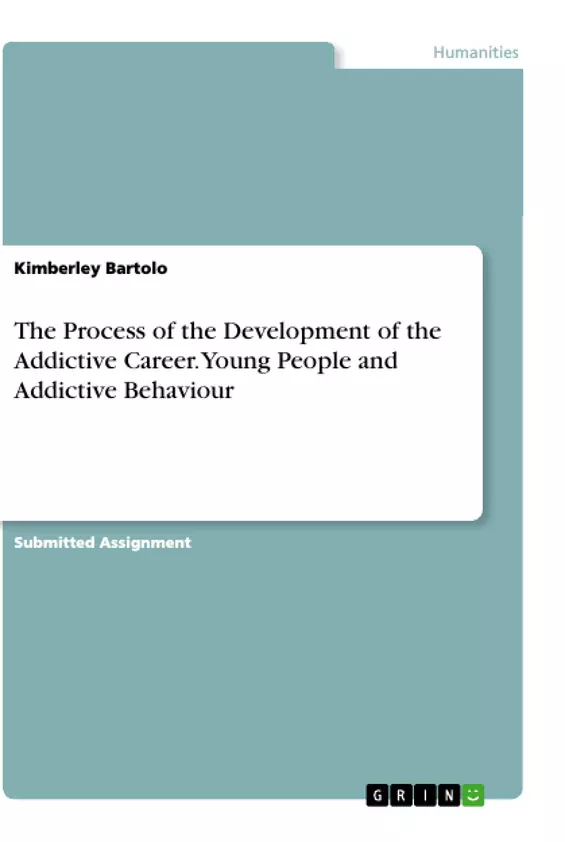The term addiction is commonly alluded in the day-to-day conversations between individuals; yet, not much thought is given on what the construct actually means. Addiction does not just happen overnight, but rather is a process that takes time to develop. It is supposedly being said that the best way to formulate and understand addiction is by utilizing a career approach. The six core components of addiction are; salience, mood modification, tolerance, withdrawal symptoms, conflict and relapse. Overall, addiction remains a construct which is still not completely understood as it is still being seen as a disease and thus, it cannot be entirely tackled.
Inhaltsverzeichnis (Table of Contents)
- Introduction
- 2 Phases of the Addictive Career
- Onset
- Escalation
- Commitment
- Desistance
- The Four Models of Addiction and Potential Interventions
- Disease and Choice Model
- Biological Construct
Zielsetzung und Themenschwerpunkte (Objectives and Key Themes)
The assignment aims to discuss the process of developing an addictive career by drawing on theoretical perspectives presented in the course. It examines the different stages of this process, highlighting the factors contributing to its progression.
- The addictive career as a process with distinct stages (onset, escalation, commitment, desistance)
- The impact of adolescent experimentation on the development of addiction
- The role of biological and social factors in addiction
- The influence of different theoretical models on understanding addiction
- Potential interventions to address addiction
Zusammenfassung der Kapitel (Chapter Summaries)
- Introduction: This section defines addiction as a chronic disorder characterized by repetitive, compulsive behaviors, even in the face of negative consequences. The evolution of the term "addiction" is discussed, highlighting its expansion beyond substance-related disorders to include behavioral addictions like gambling and internet use.
- 2 Phases of the Addictive Career: This chapter presents a four-stage model of the addictive career: onset, escalation, commitment, and desistance. The onset stage is marked by initial experimentation with addictive behaviors, often during adolescence. Escalation represents increased frequency and intensity of the addictive behavior, while commitment signifies a loss of control and preoccupation with the addiction. Desistance marks the final stage, involving efforts to quit or reduce the addictive behavior.
- Onset: This section explores the onset stage of the addictive career, focusing on the increased likelihood of experimenting with drugs or alcohol during adolescence. While not all experimentation leads to addiction, early-onset behaviors (especially alcohol and cigarettes) can significantly increase the risk of developing an addictive career.
- Escalation: This chapter examines the escalation stage, characterized by increasing dependence on the addictive behavior. Negative consequences are recognized, but the individual continues to engage in the behavior, often finding positive effects such as stress reduction or pain relief.
- Commitment: This stage highlights the loss of control over the addiction. The addicted person becomes preoccupied with the behavior and neglects other areas of life, like work and relationships.
- Desistance: This final stage discussed in the chapter marks the individual's attempts to quit or reduce their addictive behavior. The need for professional guidance and intervention is emphasized due to the difficulty of quitting alone, especially for addictive substances like alcohol, where withdrawal symptoms can be severe.
- The Four Models of Addiction and Potential Interventions: This chapter delves into four models of addiction: the Disease and Choice Model, the Biological Construct, and two other models which are not specified in the provided text. The Disease and Choice Model portrays addiction as a chronic illness caused by brain dysfunction, suggesting that addicts are victims of their condition and lack control over their choices. Potential interventions for this model emphasize raising awareness among adolescents about the fact that addiction is a choice and not a disease. The Biological Construct explains addiction through genetic predisposition and neuroadaptation, suggesting that addiction is largely predetermined by biological factors.
Schlüsselwörter (Keywords)
The key concepts and themes explored in this work include: addictive career, onset, escalation, commitment, desistance, adolescent experimentation, biological factors, genetic predisposition, neuroadaptation, disease and choice model, addiction as a chronic disorder, potential interventions, and the impact of addiction on individual and societal well-being.
- Quote paper
- Kimberley Bartolo (Author), 2019, The Process of the Development of the Addictive Career. Young People and Addictive Behaviour, Munich, GRIN Verlag, https://www.grin.com/document/501530




